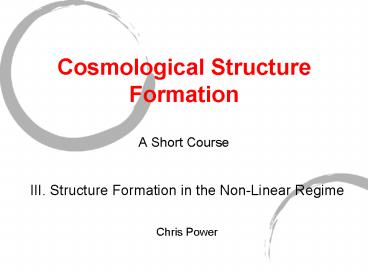Cosmological Structure Formation A Short Course - PowerPoint PPT Presentation
Title: Cosmological Structure Formation A Short Course
1
Cosmological Structure FormationA Short Course
- III. Structure Formation in the Non-Linear Regime
- Chris Power
2
Recap
- Cosmological inflation provides mechanism for
generating density perturbations - which grow via gravitational instability
- Predictions of inflation consistent with
temperature anisotropies in the Cosmic Microwave
Background. - Linear theory allows us to predict how small
density perturbations grow, but breaks down when
magnitude of perturbation approaches unity
3
Key Questions
- What should we do when structure formation
becomes non-linear? - Simple physical model -- spherical or top-hat
collapse - Numerical (i.e. N-body) simulation
- What does the Cold Dark Matter model predict for
the structure of dark matter haloes? - When do the first stars from in the CDM model?
4
Spherical Collapse
- Consider a spherically symmetric overdensity in
an expanding background. - By Birkhoffs Theorem, can treat as an
independent and scaled version of the Universe - Can investigate initial expansion with Hubble
flow, turnaround, collapse and virialisation
5
Spherical Collapse
- Friedmanns equation can be written as
- Introduce the conformal time to simplify the
solution of Friedmanns equation - Friedmanns equation can be rewritten as
6
Spherical Collapse
- We can introduce the constant
- which helps to further simplify our
differential equation - For an overdensity, k-1 and so we obtain the
following parametric equations for R and t
7
Spherical Collapse
- Can expand the solutions for R and t as power
series in ? - Consider the limit where ? is small we can
ignore higher order terms and approximate R and t
by - We can relate t and ? to obtain
8
Spherical Collapse
- Expression for R(t) allows us to deduce the
growth of the perturbation at early times. - This is the well known result for an Einstein de
Sitter Universe - Can also look at the higher order term to obtain
linear theory result
9
Spherical Collapse
- Turnaround occurs at t?R/c, when Rmax2R. At
this time, the density enhancment relative to the
background is - Can define the collapse time -- or the point at
which the halo virialises -- as t2?R/c, when
RvirR. In this case - This is how simulators define the virial radius
of a dark matter halo.
10
Defining Dark Matter Haloes
11
What do FOF Groups Correspond to?
- Compute virial mass - for LCDM cosmology, use an
overdensity criterion of , i.e. - Good agreement between virial mass and FOF mass
12
Dark Matter Halo Mass Profiles
- Spherical averaged.
- Navarro, Frenk White (1996) studied a large
sample of dark matter haloes - Found that average equilibrium structure could be
approximated by the NFW profile - Most hotly debated paper of the last decade?
13
Dark Matter Halo Mass Profiles
Dark Matter Halo Mass Profiles
- Most actively researched area in last decade!
- Now understand effect of numerics.
- Find that form of profile at small radii steeper
than predicted by NFW. - Is this consistent with observational data?
14
What about Substructure?
- High resolution simulations reveal that dark
matter haloes (and CDM haloes in particular)
contain a wealth of substructure. - How can we identify this substructure in an
automated way? - Seek gravitationally bound groups of particles
that are overdense relative to the background
density of the host halo.
15
Numerical Considerations
- We expect the amount of substructure resolved in
a simulation to be sensitive to the mass
resolution of the simulation - Efficient (parallel) algorithms becoming
increasingly important. - Still very much work in progress!
16
The Semi-Analytic Recipe
- Seminal papers by White Frenk (1991) and Cole
et al (2000) - Track halo (and galaxy) growth via merger history
- Underpins most theoretical predictions
- Foundations of Mock Catalogues (e.g. 2dFGRS)
17
The First Stars
- Dark matter haloes must have been massive enough
to support molecular cooling - This depends on the cosmology and in particular
on the power spectrum normalisation - First stars form earlier if structure forms
earlier - Consequences for Reionisation
18
Some Useful Reading
- General
- Cosmology The Origin and Structure of the
Universe by Coles and Lucchin - Physical Cosmology by John Peacock
- Cosmological Inflation
- Cosmological Inflation and Large Scale
Structure by Liddle and Lyth - Linear Perturbation Theory
- Large Scale Structure of the Universe by
Peebles































